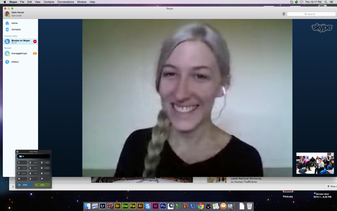
4 Advantages to Inviting Lecturers to Engage Students via Video Conferencing
1. Speakers are more likely to say yes to a proposal to speak when it is by way of video conferencing. Everyone has a busy schedule and carving out one hour is more workable than trying to find multiple days to travel and visit. It is more convenient for the visiting person to not have to leave their home. It is easier for them if they do not have to go through all the hassles of travel, what author and photo critic A. D. Coleman refers to as the added expense of, “Unnecessary wear and tear on the body”.
If presenters are reluctant to video-conference because they are pressed
for time, then there are options. Teachers can ask students to search out everything they can find on the lecturer before hand. By thoroughly researching the guest photographer the lecturer does not need to prepare and give a presentation on their work. Instead, the virtual visit can take
the form of an informal conversation between the photographer & student.
After their research, students will be familiar with the work and can be responsible for leading a discussion by having prepared authentic, essential questions for the virtual guest. Teachers can prepare students for their research by impressing up on them that the best questions cannot be found in the research students conducted. The research is intended to give rise to the deeper questions about the speaker and their work.
Final questions can be collected by the teacher and evaluated beforehand if necessary. Student may need suggestions to help clarify and focus in on the actual questions being asked. The teacher can also order and prioritize the questions to plan out the flow of the conversation. Question and answer sessions encourage interaction instead of students reverting to the familiar role of passive listeners. If students are engaged in a dialogue they are much more likely to stay attentive and be more open to learning.
2. The cost for virtual speakers is much cheaper than organizing in-person lecturers. Bringing a guest speaker to campus can cost thousands of dollar and a major time commitment on hosting faculty. An hour of video conferencing costs very little, in relationship, and when its finished everyone can go back to their pending responsibilities. Speakers are many times willing to give a talk at an hourly, reduced rate because of its convenience.
3. Video conferencing calls are easy to capture, if presenters agree to being recorded. Any kind of streaming video can be recorded with a variety of applications, like Camtasia. Recordings of the virtual visits can be made available to students for review or for students that were absent.
4. Speakers can be anywhere in the world during their visit. They could be on vacation, at another speaking engagement, or at a conference and still be willing to commit to a video-conference for an hour.
---------------------------------------------
*Photo above: Brooke Shaden visits the Photography Program at Adrian College in 2015
1. Speakers are more likely to say yes to a proposal to speak when it is by way of video conferencing. Everyone has a busy schedule and carving out one hour is more workable than trying to find multiple days to travel and visit. It is more convenient for the visiting person to not have to leave their home. It is easier for them if they do not have to go through all the hassles of travel, what author and photo critic A. D. Coleman refers to as the added expense of, “Unnecessary wear and tear on the body”.
If presenters are reluctant to video-conference because they are pressed
for time, then there are options. Teachers can ask students to search out everything they can find on the lecturer before hand. By thoroughly researching the guest photographer the lecturer does not need to prepare and give a presentation on their work. Instead, the virtual visit can take
the form of an informal conversation between the photographer & student.
After their research, students will be familiar with the work and can be responsible for leading a discussion by having prepared authentic, essential questions for the virtual guest. Teachers can prepare students for their research by impressing up on them that the best questions cannot be found in the research students conducted. The research is intended to give rise to the deeper questions about the speaker and their work.
Final questions can be collected by the teacher and evaluated beforehand if necessary. Student may need suggestions to help clarify and focus in on the actual questions being asked. The teacher can also order and prioritize the questions to plan out the flow of the conversation. Question and answer sessions encourage interaction instead of students reverting to the familiar role of passive listeners. If students are engaged in a dialogue they are much more likely to stay attentive and be more open to learning.
2. The cost for virtual speakers is much cheaper than organizing in-person lecturers. Bringing a guest speaker to campus can cost thousands of dollar and a major time commitment on hosting faculty. An hour of video conferencing costs very little, in relationship, and when its finished everyone can go back to their pending responsibilities. Speakers are many times willing to give a talk at an hourly, reduced rate because of its convenience.
3. Video conferencing calls are easy to capture, if presenters agree to being recorded. Any kind of streaming video can be recorded with a variety of applications, like Camtasia. Recordings of the virtual visits can be made available to students for review or for students that were absent.
4. Speakers can be anywhere in the world during their visit. They could be on vacation, at another speaking engagement, or at a conference and still be willing to commit to a video-conference for an hour.
---------------------------------------------
*Photo above: Brooke Shaden visits the Photography Program at Adrian College in 2015
